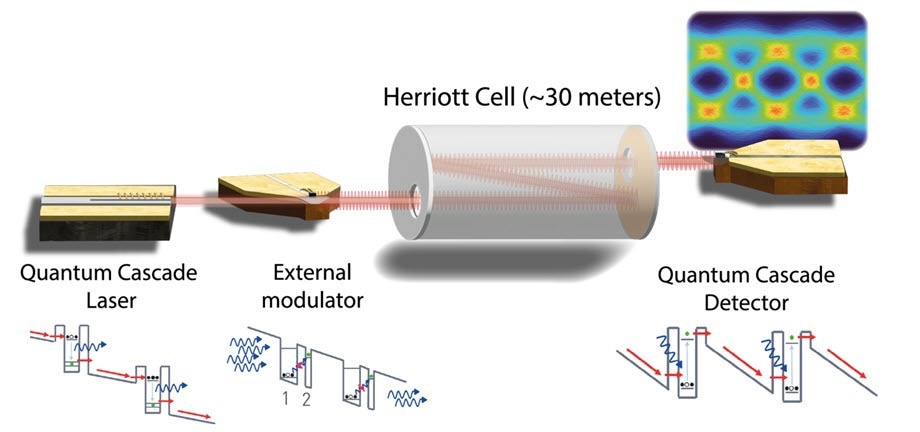Over the past several years, telecommunication has transformed many aspects of people’s lives by providing extremely simple ways to share and access data.
 Representative diagram of the experimental setup used in the study. The output of a quantum cascade laser (QCL) was modulated by a Stark effect external modulator and transmitted through a Herriott cell to simulate a light path with an effective length of over 30 m. Two different detectors, namely a quantum well-infrared photodetector (QWIP) and a quantum cascade detector (QCD) were tested on the receiver side. Thanks to techniques such as pulse shaping and pre- and post-processing, this free-space optics communication system achieved record-setting data rates. Image Credit: Pierre Didier, LTCI, Telecom Paris, Institut Polytechnique de Paris.
Representative diagram of the experimental setup used in the study. The output of a quantum cascade laser (QCL) was modulated by a Stark effect external modulator and transmitted through a Herriott cell to simulate a light path with an effective length of over 30 m. Two different detectors, namely a quantum well-infrared photodetector (QWIP) and a quantum cascade detector (QCD) were tested on the receiver side. Thanks to techniques such as pulse shaping and pre- and post-processing, this free-space optics communication system achieved record-setting data rates. Image Credit: Pierre Didier, LTCI, Telecom Paris, Institut Polytechnique de Paris.
One of the most significant facilitators for this transformation has been the acceptance and enhancement of broadband technologies, which pack massive amounts of data over wide frequency bands to realize unparalleled transfer speeds. Currently, most large cities have fiber optics-based networks that provide high-speed internet to all residences.
Setting up fiber optic links to remote locations and rural regions is not always viable due to the related costs and civil engineering work needed. Such areas could gain from a diverse approach to optical broadband communications: free-space optics.
The key concept in free-space optical (FSO) communications is to install aligned transmitter-receiver pairs where required and use air to transmit the signals. While there are still numerous difficulties to resolve in FSO platforms (such as the impact of weather, low energy efficiency, and high background noise), global researchers are endlessly attempting new methods of solving these difficulties and realizing higher data rates.
Against this setting, a team of researchers at Institut Polytechnique de Paris and scientists from École Normale Supérieure in France, recently achieved considerable progress in FSO communications using unipolar quantum optoelectronic (UQO) devices.
The researchers successfully created long-range FSO links using an outer modulator based on the Stark effect related to two types of UQO detectors in the receiver. They accomplished unparalleled data rates with this technology, demonstrating their unexploited potential. Details of their efforts are reported in Advanced Photonics.
The transmitter and the two detectors used by the scientists in their system work in the mid-infrared range, using wavelengths from 8 to 12 µm. In this frequency range, the signal experiences very low absorption, scattering, and distortion during its transmission in the air.
The transmitter side used a commercial quantum cascade laser running at room temperature integrated with a unique external modulator. The detector side (which should correctly sense and deduce small and noisy signals) used either a quantum well-infrared photodetector (QWIP) or a quantum cascade detector (QCD).
The latter is more complicated and usually performs better but has to be nitrogen-cooled, whereas the QCD can remain uncooled and used at ambient temperature. There is a compromise between the performance, intricacy, and cost of the two UQO detectors.
First, the researchers assessed the highest data rate of their FSO link in “back-to-back configuration,” which means straightaway transmitting the output of the transmitter into the input of the detector. Next, they added a commercial Herriott cell between the two.
This hermetic tool comprises carefully engineered mirrors to enable an input optical signal to bounce back and forth numerous times before it exits, mimicking a greater distance for the signal to travel. Here, the optimal length of the light path was 31 m.
To enhance the performance of their communication platform in terms of error resistance and speed, the team exploited many independent methods, namely pulse shaping the transmitted signal combined with a few pre- and post-processing techniques.
We achieved a record-setting bitrate of 30 Gbit/s for both 2-level (OOK) and 4-level (PAM-4) modulation schemes in a 31-meter propagation link. Moreover, the observed bit error rates were compatible with established error-correction algorithms that can be implemented at the receiver’s end.
Pierre Didier, Study Corresponding Author and PhD student, Prof. Frédéric Grillot’s Group, Télécom Paris
Notably, this is the first time an FSO transmission platform has accomplished high data rates at such a long distance in the 8-12 µm wavelength range. Therefore, this study marks a major step toward achieving high-speed FSO telecommunication links resistant to weather by employing UQO devices.
Additional developments in the incorporation of UQO devices, as well as enhancements in the backing optics and electronics, can help provide high-speed internet to remote locations.
Journal Reference:
Didier, P., et al. (2022) High-capacity free-space optical link in the midinfrared thermal atmospheric windows using unipolar quantum devices. Advanced Photonics. doi.org/10.1117/1.AP.4.5.056004.